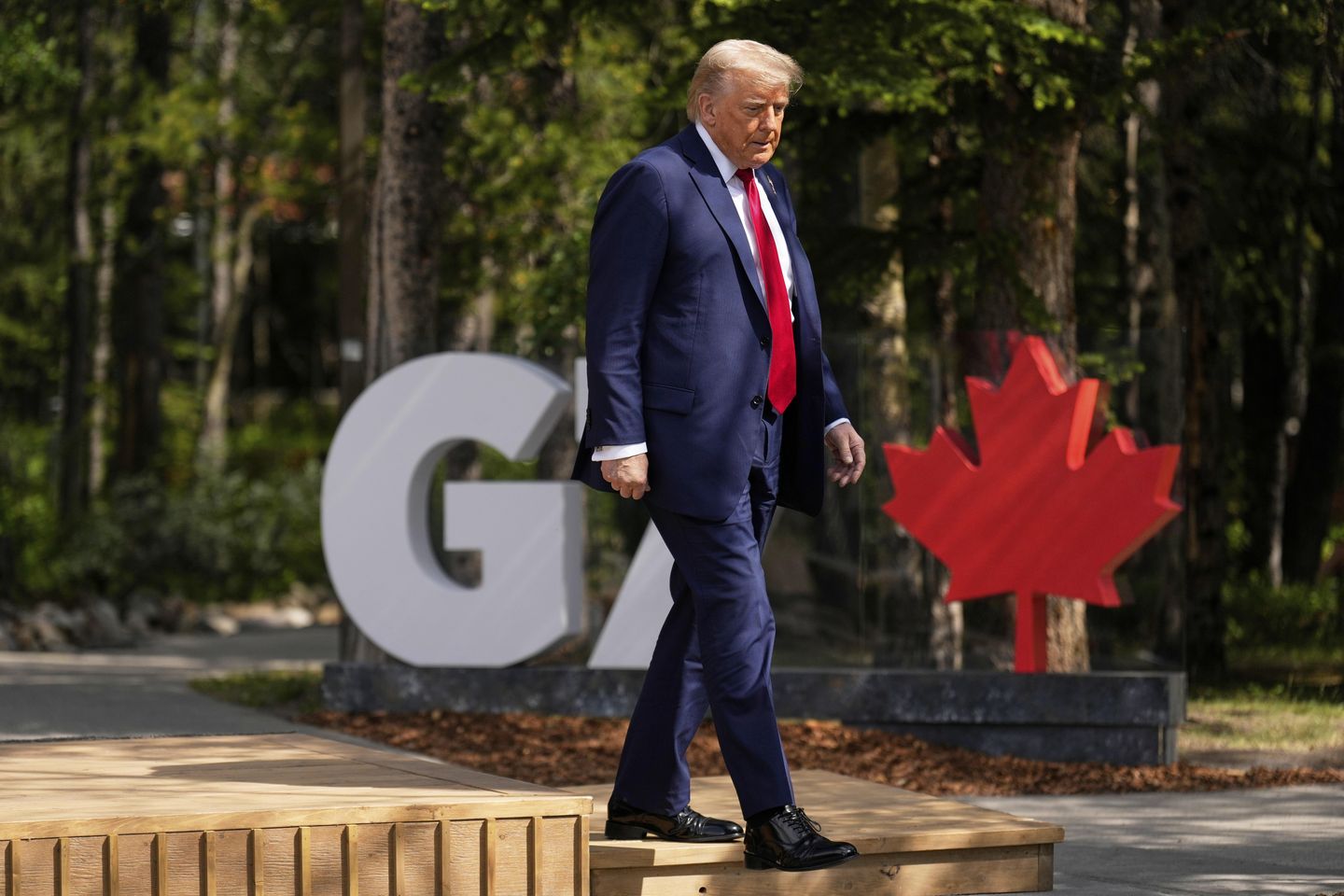
President Trump said Monday he is optimistic he can strike a trade deal with Canadian Prime Minister Mark Carney as the leaders of major economies sought tariff relief from the U.S. at the Group of Seven summit.
Mr. Trump, speaking alongside Mr. Carney in Alberta, said the main sticking point is his preference for tariffs versus Mr. Carney’s reluctance to rely on import duties.
“I’m sure we can work something out,” Mr. Trump said. “I think we have different concepts. I have a tariff concept. Mark has a different concept.”
Officials in the Trump administration eyed 90 deals in 90 days after Mr. Trump in April announced, then paused, hefty tariffs on trading partners that sell plenty of products to the U.S. market but don’t buy nearly as much from American producers.
But so far, the White House has reached just one agreement — a deal in principle with Britain — as it eyes a July deadline to ink pacts or reimpose big tariffs on dozens of nations.
“We just signed it and it’s done,” Mr. Trump said Monday with U.K. Prime Minister Keir Starmer, as they finalized aspects of the deal related to slashing tariffs on a quota of British cars. “The relationship that we have is fantastic.”
Mr. Trump has suggested he might impose tariffs on nations once more, though the sidelines of the G7 summit in Canada offered allies a chance to bend the U.S. president’s ear.
Japanese Prime Minister Shigeru Ishiba is seeking good terms on trade to protect his export-heavy economy, and key leaders from the European Union — French President Emmanuel Macron, German Chancellor Friedrich Merz and Italian Prime Minister Giorgia Meloni — are on hand for the summit that ends Tuesday.
“There will be no solution at this summit, but we could perhaps come closer to a solution in small steps,” Mr. Merz told reporters.
Mr. Trump has rankled allies on trade since the start of his second term.
The president says the U.S. effectively subsidizes other nations by accepting their goods even though those nations block U.S. products from their own markets.
Some analysts say the situation is a distraction from major issues before the G7.
“The G7 allies could use the time together to discuss Ukraine, the Middle East, China, and other shared challenges. Instead, they will spend much of the time mollifying President Trump and trying to contain damage from his tariffs,” said Ryan Young, a senior economist at the Competitive Enterprise Institute, a free-enterprise think tank. “Trump’s tariffs are also splitting the G7 into a six-against-one alliance. These avoidable tensions must delight [Russian President] Vladimir Putin, [Chinese President] Xi Jinping, and other autocrats. Not only are tariffs weakening the free world economically, the squabbling they cause is weakening them diplomatically.”
Some G7 leaders might just want to stall for time. The courts are scrutinizing Mr. Trump’s tariff authority, and Congress might step in if the White House’s unilateral tariffs cause an economic downturn.
“From that perspective, if [allies] can get through the summit without any major tantrums, it will be a success,” Mr. Young said. “If accomplishing that means making some kind of tariff deal, expect some handshake agreements. If that’s not necessary, the other leaders will be happy to put off any tariff negotiations for another time.”
The U.S. and Canada, at least, showed an interest Monday in kick-starting some sort of an agreement.
The U.S. had a $63 billion trade deficit with G7 host-nation Canada in 2024, and Mr. Trump likes to joke that Canada should be the “51st state” because it relies so heavily on its economic ties with the U.S.
Mr. Trump in March imposed a 25% tariff on Canadian goods that enter the U.S., although many products are exempt under the U.S.-Canada-Mexico Agreement that Mr. Trump negotiated in his first term.
The president said he issued the tariff because Canada wasn’t doing enough to stop fentanyl trafficking across the U.S. border, even though the lion’s share of the drug traverses the U.S.-Mexican border.
Then, Mr. Trump imposed a 25% tariff on cars and auto parts, and recently doubled a tariff on steel and aluminum imports from 25% to 50%. Those tariffs are a major sore point for Canadians, whose auto and metal industries are closely intertwined with U.S. sectors.
Canadians have responded to Mr. Trump’s economic threat by launching a “Buy Canadian” campaign to increase purchases of their goods.
Mr. Carney and his Liberal Party also rode the wave of economic nationalism and anti-Trump fervor to his surprise victory in Canadian elections this year.


![Former Bravo Star Charged After Violent Assault Using a Rock-Filled Sock in Tennessee Walmart [WATCH]](https://www.right2024.com/wp-content/uploads/2025/07/Former-Bravo-Star-Charged-After-Violent-Assault-Using-a-Rock-Filled-350x250.jpg)



![Karoline Leavitt Levels CNN's Kaitlan Collins and Other Legacy Media Reporters [WATCH]](https://www.right2024.com/wp-content/uploads/2025/07/Karoline-Leavitt-Levels-CNNs-Kaitlan-Collins-and-Other-Legacy-Media-350x250.jpg)
![Man Arrested After Screaming at Senators During Big Beautiful Bill Debate [WATCH]](https://www.right2024.com/wp-content/uploads/2025/06/Man-Arrested-After-Screaming-at-Senators-During-Big-Beautiful-Bill-350x250.jpg)


![Illegal Alien Walked Free After Decapitating Woman, Abusing Corpse for Weeks [WATCH]](https://www.right2024.com/wp-content/uploads/2025/07/1753013138_Illegal-Alien-Walked-Free-After-Decapitating-Woman-Abusing-Corpse-for-350x250.jpg)






